Video production is a key skill in today’s digital age. Labridge Digital Marketing knows this well. That is to say, it’s about creating videos that tell a story or share a message. So, why is it important? For one, videos can reach a lot of people. They are easy to share and can be very engaging. In other words, if you want to get your idea out there, video production can help.
Also, it doesn’t have to be hard. With the right approach, anyone can start making videos. That is to say, you don’t need expensive equipment or deep technical know-how. What you do need is a clear plan and a creative mind. For instance, think about what story you want to tell. After that, consider how to tell it in a way that catches attention.
Therefore, starting with video production can be a great move. Above all, remember that Labridge Digital Marketing is here to guide you through your video production journey. Making videos can boost your message and connect with people all around the world. So, let’s dive in and explore how you can make impactful videos.
Understanding Video Production

Video production is like telling a story with pictures and sound. It’s a way to share your ideas with the world. So, what is video production, really? It’s the process of making a video, from thinking of an idea to sharing it with others. In other words, this includes planning, filming, and editing.
For insights into video production and its role in content marketing in the Philippines, explore the strategies and techniques employed by professionals in the industry.
Planning Your Video
Before you start filming, you need to plan. That is to say, you should know what story you want to tell. Think about your message. Also, decide where you will film and who will be in your video.
This step is key to making sure everything goes smoothly later on. For guidance on effective planning and its significance in content strategy development, delve into the methodologies employed by experts in the field.
Filming Techniques
After planning comes the filming part. Here, you capture your story on camera. Keep things simple. Also, use a steady hand or a tripod to keep your video smooth. Good lighting helps, too. In other words, make sure your subject is well-lit and easy to see. For instance, filming during the day can give you lots of natural light.

See How My Team Can Drive More Traffic to Your Website
- SEO – unlock more SEO traffic. See real results.
- Content Marketing – our team creates epic content that will get shared, get links, and attract traffic.
- Paid Media – effective paid strategies with clear ROI.
Editing Your Video
Once you’ve filmed your story, it’s time to edit. This means putting your clips together to tell your story. You can also add music or voice overs. Also, editing lets you polish your video. Therefore, take your time with this step. There are free and paid software options that are user-friendly for beginners.
Sharing Your Video
Above all, after your video is finished, you’ll want to share it. This could be on social media content creation, a website, or even in an email marketing campaigns. So, think about where your audience spends their time. That’s where your video should go.
So, you’re ready to start your video production journey. Remember, practice makes perfect. It’s okay if your initial videos aren’t flawless. Also, each video is a chance to learn and improve. In addition, keep exploring new ideas and techniques. Video production is a fun and creative way to express yourself.
Types of Video Production
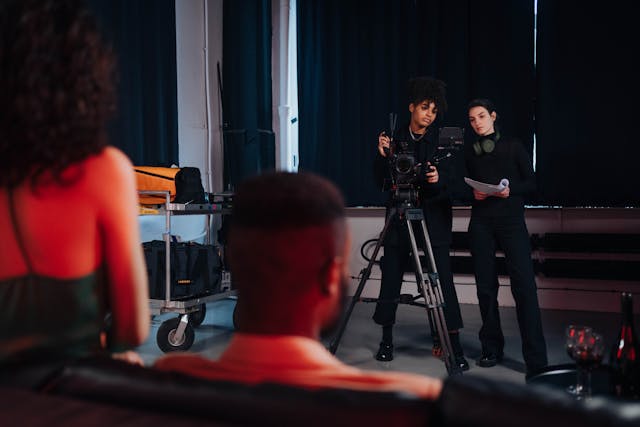
Video production comes in many shapes and sizes, each serving a different purpose. So, let’s dive into some common types.
Corporate Video Production
Corporate videos are all about business. For instance, they can introduce a company, showcase services, or train staff. It’s a way to connect with customers and employees. So, creating a video that reflects a company’s values is key.
Example:
A company like “Google” might use corporate videos for internal training or to share their culture with the world through an “About Us” video on their website. Such videos convey the company’s mission, culture, and values, aiming to build trust and rapport with the audience.
Commercial Video Production
Commercial videos are made to sell. That is to say, they promote products or services to viewers. So, think of a TV ad for a new snack. That’s commercial video production. The challenge here is to grab attention quickly and make people want to buy. Therefore, creativity is a must.
Local influencers collaborations can be an effective strategy in enhancing the reach and impact of commercial videos, as they can help in endorsing the product or service to their followers.
Example:
The classic “Old Spice” commercials, which combine humor and surreal imagery, effectively capture attention and promote the brand’s products in a memorable way.
Documentary Filmmaking
Documentaries tell real-life stories. In other words, they explore subjects in depth, from nature to human experiences. For instance, a documentary about the ocean’s depths shows unseen worlds. Making documentaries requires research and a passion for storytelling. Above all, it’s about sharing truth and knowledge.
Example:
“The Social Dilemma” on Netflix delves into the impact of social media on society, combining personal stories with expert insights to engage and educate viewers.
Event Videography
Event videography captures special moments. For instance, this could be a wedding, a concert, or a conference. The goal is to record the event as it happens. So, being prepared and adaptable is important.
Example:
The “Live Aid” concert of 1985, one of the largest-scale television broadcasts of all time, brought global attention to famine in Ethiopia, showcasing the power of event videography to capture and convey significant moments in history.
Educational Video Production
Educational videos teach. They can be about anything from math to music. Think of a video lesson on playing the guitar. These videos make learning accessible and fun. The challenge is to present information clearly and engagingly. Therefore, understanding your audience’s needs is crucial.
Example:
“Khan Academy” offers a vast library of educational videos on topics ranging from mathematics to art history, demonstrating how video can be used to enhance learning and accessibility for students worldwide.
Each type of video production offers unique opportunities and challenges. But the goal is always the same: to tell a story that resonates with viewers. Whether it’s selling a product or sharing knowledge, video production is a powerful tool. So, grab a camera and start exploring the world of video creation. Remember, every video is a chance to connect, teach, and inspire.
Tools for Video Production
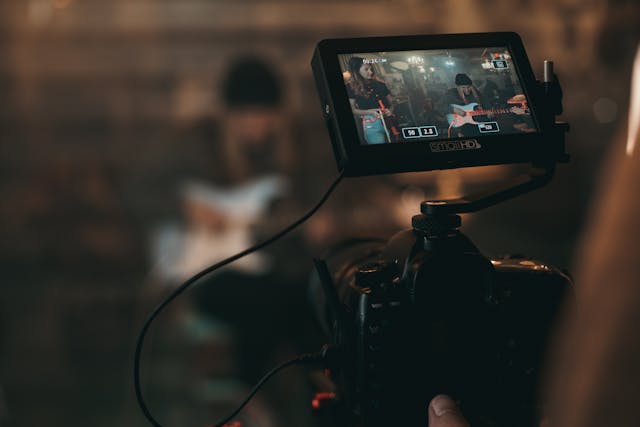
Video production is more than just hitting the record button on your camera. It’s a process that combines technology and creativity to create something amazing. Now, let’s discuss the equipment required. So, from cameras to editing software, each tool plays a part. That is to say, they all come together to help you tell your story.
Essential Camera Equipment for Quality Video
First things first, you need a camera. But not all cameras are the same. For beginners, a smartphone or a basic DSLR camera can work wonders. For instance, the Canon EOS Rebel series is user-friendly and takes great videos. If you have more to spend, consider a mirrorless camera like the Sony A7 III. It’s light and records in high quality. Therefore, your choice depends on your budget and needs.
Examples:
- Smartphone Camera: Modern smartphones like the iPhone 12 or Samsung Galaxy S21 have excellent video capabilities, perfect for beginners.
- DSLR Camera: Canon EOS Rebel T7i – A user-friendly DSLR that offers great video quality for those stepping up from smartphones.
- Mirrorless Camera: Sony A7 III – Offers superb image quality in a lighter body than DSLRs, ideal for intermediate to advanced users.
Lighting Tools for Professional-looking Videos
Good lighting makes your video look professional. You don’t need fancy lights to start. In other words, natural light from a window can work well. But, for more control, LED panels or ring lights are great options. That is to say, they are not too expensive and can brighten up your videos.
Examples:
- Natural Light: Free and readily available. Positioning your subject near a large window can provide excellent lighting for video shoots.
- LED Panels: Neewer 5600K USB LED Panels offer adjustable lighting and are budget-friendly, suitable for indoor shoots.
- Ring Lights: The Neewer Ring Light Kit provides even, soft light directly onto the subject, great for vlogs or interviews.
Audio Equipment for Clear Sound Recording
Clear audio is key. Viewers might forgive a less-than-perfect video quality, but bad sound can turn them away. A simple lapel microphone can greatly improve sound quality. Also, a shotgun mic is great for picking up sound directly in front of it.
Examples:
- Lapel Microphone: The Rode smartLav+ can connect to smartphones or cameras, offering clear audio for interviews or talking head videos.
- Shotgun Mic: Rode VideoMic Go is a highly directional mic that mounts on the camera, ideal for capturing audio from the subject.
Video Editing Software for Post-Production
After filming, you need to edit your videos. Luckily, there are editing programs for all skill levels.
Examples:
- For Beginners: iMovie (Mac) and Shotcut (Windows/Mac/Linux) are free and offer intuitive editing interfaces for those new to video editing.
- For Advanced Users: Adobe Premiere Pro is a professional-grade editing software with comprehensive features and tools for detailed video production.
Accessories and Miscellaneous Tools
Lastly, don’t forget about accessories. Tripods keep your camera steady. SD cards store your footage. And, a good camera bag protects your gear. These items might seem small, but they are essential for video production. After that, with the right accessories, filming becomes easier and more enjoyable.
Examples:
- Tripods: The Manfrotto Compact Action Aluminum Tripod is lightweight and portable, providing stable support for cameras or smartphones.
- SD Cards: SanDisk Extreme PRO SDXC UHS-I Card is reliable for storing high-quality video files, ensuring you don’t run out of space during shoots.
- Camera Bags: The Lowepro Fastpack BP 250 AW II offers protection and organization for your camera gear, with dedicated spaces for cameras, lenses, and accessories.
In conclusion, starting in video production might seem daunting at first. However, with the right tools, anyone can create engaging videos. Remember, it’s not about having the most expensive equipment but understanding how to use what you have effectively. Therefore, focus on building your skills and adding tools as you go. Above all, enjoy the process of bringing your visions to life through video.
Pre-Production Planning

Pre-production planning is the first step in creating a video. That is to say, this phase is all about preparation. It lays the groundwork for all future steps. So, why is this planning so crucial? It helps save time, money, and stress by sorting out details beforehand.
So, let’s dive into the steps involved. For insights into the significance of pre-production planning and its relevance in article and blog writing, explore the strategies employed by professionals in the field.
Step-by-step Guide for Crafting a Storyboard for Your Video
A storyboard is like a comic strip for your video. Therefore, it shows the main scenes in order. So, here’s how to make one:
- Start with a Script: Write down what happens in each scene.
- Draw the Scenes: Sketch what each shot will look like. Simple drawings work fine.
- Add Details: Note camera angles and movements, lighting, and any dialogue.
Crafting a storyboard helps you visualize the video before filming. So, this makes shooting much smoother.
Choosing the Right Video Cameras
Your choice of camera can affect your video’s look and feel. Therefore, here’s what to consider:
- Purpose: What are you filming? A documentary might need a different camera than a music video.
- Budget: More expensive doesn’t always mean better. Decide how much you can spend.
- Features: Think about size, weight, battery life, and image quality.
For most beginners, a good smartphone or a DSLR camera works well. So, as you get more experience, you might look into mirrorless cameras for higher quality.
The Role of Scripting in Video Production
Scripting isn’t just writing what people say. It’s planning the video’s content from start to finish. So, here’s why it matters:
- Direction: A script guides everyone involved in the production.
- Timing: It helps you figure out how long your video will be.
- Message: It ensures your video clearly communicates your ideas.
Writing a script is about organizing your thoughts and making sure your video tells your story effectively.
Pre-production planning is a crucial part of video production. It’s where your video starts to take shape. By taking the time to plan, you can avoid problems later on. That is to say, good planning leads to better videos. Therefore, don’t skip this step. After all, every great video begins with a great plan.
Production Techniques
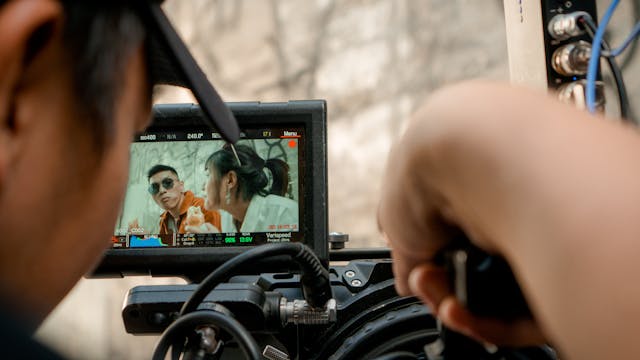
When we talk about making videos, how you shoot is just as important as what you shoot. Good production techniques can turn a simple video into something much more professional and engaging. So, let’s break down some key areas: lighting, audio, and framing. These are the building blocks for great video production.
Mastering Video Lighting Setup
Good lighting makes everything look better. It’s true for selfies, and it’s true for video production too. Here’s the correct approach:
Use Natural Light
If you can, shoot in natural light. It’s free and looks great. To clarify, just make sure the light is in front of your subject, not behind.
Try Three-Point Lighting
This setup uses three lights to light your subject from different angles. In other words, it reduces shadows and gives your video a professional look.
Keep It Soft
Soft light is more flattering than hard light. Also, you can soften light with diffusers or even a white sheet.
Remember, playing with light is like adding seasoning to food. It’s all about balance.
Audio Recording Techniques for Video
Great sound is half the picture. That is to say, bad audio can ruin a good video. So, here’s how to capture clear sound:
- Get Close: The closer your microphone is to the subject, the better the sound.
- Avoid Noise: Background noise can be a distraction. Try to film in quiet locations.
- Use a Good Mic: A decent microphone is a wise investment for video production. Also, even a basic lapel mic can improve your audio dramatically.
Good audio makes your video feel polished and professional.
Framing and Composition Basics
How you frame your shot can tell a story all by itself. Here are some tips:
Follow the Rule of Thirds
Envision your frame as divided into nine equal sections by two vertical and two horizontal lines. Also, place your subject along these lines or at their intersections.
Keep It Level
Make sure your horizon is straight. That is to say, a tilted frame can disorient your viewers.
Play with Angles
Different angles can add interest and perspective to your shots. So, don’t be afraid to experiment.
Framing is about guiding where your viewer looks. Use it wisely.
Great video production is more than just pressing record. That is to say, it’s about using light, sound, and framing to bring your vision to life. Thus, dedicate time to honing these methods. After all, every shot is a chance to improve. And also remember, the best way to learn is by doing. So, grab your camera and start experimenting. With each video, you’ll get better and better.
Post-Production and Editing
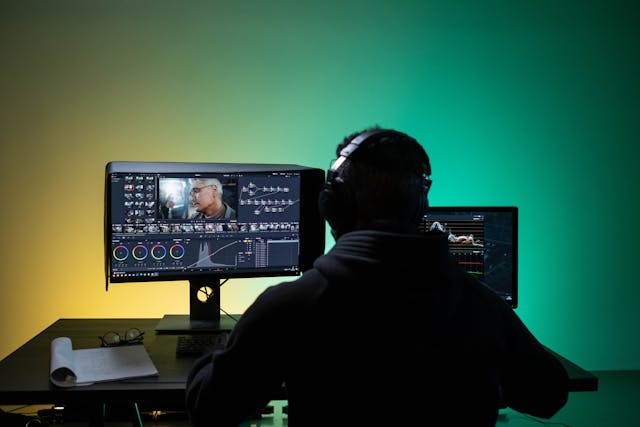
After the cameras stop rolling, the post-production phase begins. This is where it happens in video production. That is to say, editing, adding music, and color grading are key steps that transform raw footage into a compelling story. So, let’s explore how beginners can master these techniques.
Video Editing Techniques for Beginners
Editing is all about storytelling. Here’s how to start:
- Cutting: Learn to cut your clips to keep only the best parts. Keep it tight and focused.
- Transitions: Use simple transitions like fades or cuts. They help move the story along without distracting.
- Sequence: Arrange your clips in a logical order that tells your story. What happens first, next, and last?
Remember, practice makes perfect. So, the more you edit, the better you’ll get.
Adding Music and Sound Effects
Music and sound effects add emotion and depth to your video. Here’s how to use them:
- Background Music: Choose a track that matches the mood of your video. It should support, not overpower, your visuals.
- Sound Effects: Use sound effects to add realism or emphasize points. For instance, a doorbell sound when someone arrives.
- Volume Levels: Make sure your music and effects are not too loud. They should blend smoothly with your dialogue.
Sound brings your video to life, so choose wisely.
Color Grading Your Video
Color grading is like adding a filter to your video. It sets the tone and style. Here’s what to know:
- Consistency: Keep your color grading consistent throughout the video. It ought to appear as a unified whole.
- Mood: Use colors to enhance the mood. Warm colors for happy scenes, cool colors for sad or tense scenes.
- Software: Many editing programs have color grading tools. Start with presets and adjust as needed.
Color grading can dramatically change the look and feel of your video.
The post-production phase is crucial in video production. It’s where you refine your story and polish your visuals. By mastering editing, sound, and color grading, you can elevate your video from good to great. Remember, each step is an opportunity to enhance your storytelling. Therefore, take your time, experiment, and see what works best for your video. With practice, you’ll find your unique style and voice in the world of video production.
Distributing Your Video Content

Once you’ve crafted your video, the next step in video production is to share it with the world. Distribution is key to making sure your hard work gets seen by as many people as possible. This means picking the right places to share your video and making sure it’s easy for people to find. Let’s break down how to do this effectively.
Choosing the Right Platform for Video Distribution
Not all platforms are created equal. Here’s how to pick the right one for your video:
- Know Your Audience: Where do they spend their time online? YouTube might be great for tutorials, while Instagram is better for short, engaging clips.
- Understand the Platform’s Format: Each platform has its own rules for video. As an example, vertical videos are most effective on TikTok.
- Consider Your Goals: Are you looking to inform, entertain, or sell? Your goal can help determine where to post your video.
Choosing wisely means your video is more likely to reach the right people.
Video SEO: Optimizing Your Video for Search
Getting your video to show up in search results can hugely boost your views. Here’s how:
- Use Keywords: Just like with websites, use relevant keywords in your video’s title, description, and tags.
- Create a Captivating Thumbnail: A good thumbnail can make people want to click on your video.
- Encourage Engagement: Ask viewers to like, comment, and share your video. This interaction can help increase its visibility.
SEO for videos is about making it easy for people to find your content.
Engaging Your Audience Through Video Content
Engagement doesn’t stop at getting views. Here’s a method to ensure your audience returns:
- Provide Value: Whether it’s entertainment, information, or both, make sure your video offers something valuable.
- Interact with Your Viewers: Respond to comments and feedback. This can build a community around your videos.
- Be Consistent: Regularly posting new content keeps your audience engaged over time.
Engagement is about building a relationship with your viewers.
Distribution is a crucial part of the video production process. It’s how you ensure your video reaches your audience and achieves its purpose. By choosing the right platforms, optimizing for search, and engaging with your viewers, you can maximize your video’s impact.
Remember, the goal is to share your story with as many people as possible. So, take the time to plan your distribution strategy carefully. After all, your video deserves to be seen.
Latest Trends in Video Production
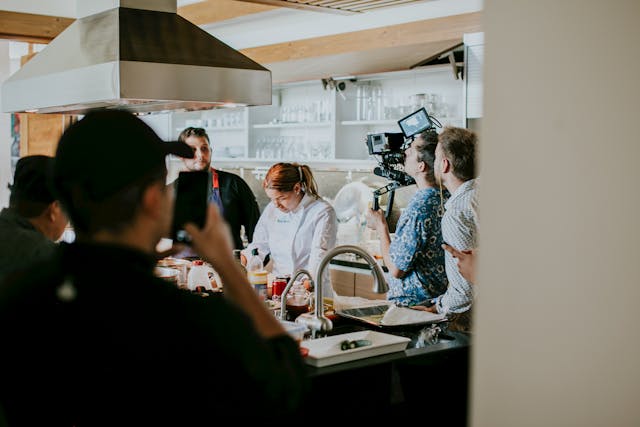
Video making is always getting better, with new tools and ways to watch. From super clear images to feeling like you’re right inside the video, let’s check out what’s hot in video making now.
Better Tech for Videos
Nowadays, videos look clearer than ever. Think about how great movies look on your TV. Plus, we have drones – those flying cameras – that can take amazing shots from up high, like a bird flying over a city. This means even if you’re making a video on a small budget, you can still get some pretty awesome shots.
360-Degree Videos
Have you ever watched a video where you can look around, not just where the camera is pointing? That’s what 360-degree videos let you do. You can control where to look, whether it’s up at the sky or down at the ground. It’s like being right there where the video is happening.
Stepping Into Videos with VR
Virtual reality, or VR, is another cool thing. With a special headset, it feels like you’re inside the video. It’s great for when you want to feel like you’re somewhere else, like walking on the moon or diving under the sea. VR makes videos feel super real.
Easy and Smart Video Editing
Editing videos is getting easier and smarter. Now, there are tools on the internet that let you and your friends work on a video together, even if you’re in different places. Also, some smart tools can fix colors or make the sound better without you needing to do much. This implies that you can allocate additional time to creativity.
Making videos is getting more exciting with all these new tools and ways to watch. Whether you’re using drones, making videos you can step into, or editing your videos with smart tools, there’s so much you can do now. It’s a great time to start making your own videos and sharing your stories with the world.
Conclusion
Wrapping up, making videos, or video production, has lots of steps, but it’s worth it. From planning to sharing your video, every step lets you be creative. Remember, using the right tools and techniques can really make your videos shine. And hey, it’s okay if your first try isn’t perfect.
Each video you make is a chance to learn and get better. Labridge Digital Marketing believes in growing and improving, one video at a time. So, go ahead and start creating. Your next video could be the one that really connects with people all over.
FAQs
What do I need to start making my own videos?
Just grab your phone, something to keep it steady like a small tripod, and a quiet spot. If you want to edit your video, there are free apps you can use.
Can I really make good videos with my phone?
Yes, you can! Phones these days have great cameras. Just make sure you have enough light and try to keep your phone steady.
How can I make my videos look more professional?
Good light, clear sound, and steady video are key. Also, learning to trim and tidy up your video with editing can make a big difference.
Where should I post my video?
Think about who you want to watch your video. Different social media sites have different kinds of viewers. Pick one that fits your video best.
What’s a 360-degree video and how do I make one?
It’s a video where you can look around in all directions. You need a special camera for it, and software to put it all together.
Is it hard to make a virtual reality (VR) video?
VR videos need special gear and software. They’re a bit more complicated but really cool because they can make you feel like you’re really there.
Why should I edit my video?
Editing helps you put your video together just right, take out any mistakes, and add music or sounds to make it better.
How do I get more people to see my video online?
Use words in your video’s title and description that people might search for. A catchy picture for your video can also make people want to watch it.
How can I keep people interested in my videos?
Share stuff people like, whether it’s funny, interesting, or something to learn. Talk to your viewers in the comments and keep making new videos.
What’s the best way to get better at making videos?
Keep practicing! Try new things, see what others are doing and learn from it. Don’t worry about messing up. It’s all part of learning.